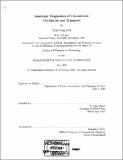| dc.contributor.advisor | R. Alan Plumb. | en_US |
| dc.contributor.author | Koh, Tieh-Yong, 1972- | en_US |
| dc.contributor.other | Massachusetts Institute of Technology. Dept. of Earth, Atmospheric, and Planetary Sciences. | en_US |
| dc.date.accessioned | 2010-10-29T18:02:02Z | |
| dc.date.available | 2010-10-29T18:02:02Z | |
| dc.date.copyright | 2001 | en_US |
| dc.date.issued | 2001 | en_US |
| dc.identifier.uri | http://hdl.handle.net/1721.1/59649 | |
| dc.description | Thesis (Ph. D.)--Massachusetts Institute of Technology, Dept. of Earth, Atmospheric, and Planetary Sciences, 2001. | en_US |
| dc.description | Includes bibliographical references (p. 279-287). | en_US |
| dc.description.abstract | This thesis examines the mid-latitude circulation and tracer transport using zonal average isentropic diagnostics. The Underworld (i.e. the region roughly below the 300K-isentrope) is targeted by our research. Currently, there is a lack of rigorous and consistent theoretical formalism to deal with isentropes that intersect the Earth's surface. In this thesis, we develop such a formalism and use it to address three main questions: (1) How is the mean circulation forced by the eddies in the region - dubbed "surface zone" - where isentropes intersect the surface in the longitude-height plane? (2) What are the pathways of global chemical transport due to mean circulation and eddies? (3) How are eddy chemical and PV transports related? A primitive-equation model on a sphere, equipped with simple physical parametrizations and on-line tracer transport, is used to investigate these questions. We tackle question (1) by looking for explanations in terms of angular momentum balance and surface heat transport. Our results show that equatorward PV flux forces a poleward mean flow in the warmer region of the surface zone. In the colder region, an equatorward mean flow is forced by eastward surface form drag, which is attributed to poleward eddy heat, flux at the surface. | en_US |
| dc.description.abstract | (cont.) We also evaluate and modify the kinematic explanation put forth by Held and Schneider (1999). As regards question (2), we found that idealized chemical tracers released into the planetary boundary layer (PBL) are transported equatorward in the surface zone by the mean circulation and the eddies. Some are recirculated polewards by the eddies, both along the surface and along isentropes (in the absence of latent heat release). Mid-tropospheric tracers are adiabatically transported by eddies into the mid-latitude PBL. Question (3) is addressed using a diffusive formulation for isentropic eddy transport. The eddy-diffusion coefficients for several idealized chemicals of lifetime 20 days agree rather well, demonstrating the usefulness of the parametrization. But the eddy-diffusion coefficient for PV, while showing the same enhancement at steering levels, is sufficiently different from chemical eddy-diffusion coefficients to imply that diabatic heating is significant in a baroclinic wave. | en_US |
| dc.description.statementofresponsibility | by Tieh-Yong Koh. | en_US |
| dc.format.extent | 287 p. | en_US |
| dc.language.iso | eng | en_US |
| dc.publisher | Massachusetts Institute of Technology | en_US |
| dc.rights | M.I.T. theses are protected by
copyright. They may be viewed from this source for any purpose, but
reproduction or distribution in any format is prohibited without written
permission. See provided URL for inquiries about permission. | en_US |
| dc.rights.uri | http://dspace.mit.edu/handle/1721.1/7582 | en_US |
| dc.subject | Earth, Atmospheric, and Planetary Sciences. | en_US |
| dc.title | Isentropic diagnostics of mid-latitude circulation and transport | en_US |
| dc.type | Thesis | en_US |
| dc.description.degree | Ph.D. | en_US |
| dc.contributor.department | Massachusetts Institute of Technology. Department of Earth, Atmospheric, and Planetary Sciences | |
| dc.identifier.oclc | 49545823 | en_US |
